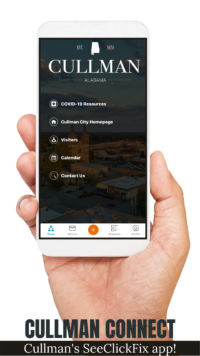Traffic Calming Request Policy
The purpose of this policy is to effectively address safety concerns due to vehicular traffic on residential streets within the city limits of Cullman. This policy will serve as a guideline for the process for citizens to follow in order to present a complaint and to request consideration for the implementation of traffic calming measures, given such measures are warranted. The goal is to:
- Provide safe environments for pedestrians and bicyclist in vehicular areas.
- Attempt to reduce the vehicular travel speed and volume to an acceptable level on residential streets.
- Reduce vehicular crash rate and severity.
- Reduce cut-through vehicular traffic on residential streets.
- Ensure overall safety and livability of residential neighborhoods.
- Keep emergency vehicle access preserved at levels that meet national response standards and local requirements.
- Ensure that any traffic calming measure taken is designed and implemented in conformance with good engineering practices.
Traffic Calming Measures Considered Under this Policy
Signage:
|
Pavement Marking/Striping:
|
Roadway Modifications:
|
Traffic Calming Measures NOT Considered Under this Policy
Per the Federal Highway Administration’s Manual on Uniform Traffic Control Devices for Streets and Highways Section 2B.04.05: “YIELD or STOP signs should not be used for speed control.” A request submitted for a stop sign to control vehicular speeding will be denied.
Traffic Calming Request Procedure
- Step 1: Initiate Traffic Calming Request: Traffic Calming Request Form must be completed by a resident from the street or neighborhood of concern or by a representative of an HOA if the street is located within a neighborhood with an active Homeowners Association (HOA). This form is not considered the ‘petition’ and therefore only needs the signature of the individual initiating the request. The form is available for download here. You can also contact us at 256-775-7109 to request the form. Completed forms can be returned by one of the following methods:
- By email: [email protected]
- By fax: (256) 775-7132
- By mail: Cullman Engineering Department, P.O. Box 278, Cullman, AL 35056-0278
- In person: Cullman City Hall Administration, 204 2nd Avenue NE, Cullman, AL 35055
.
- Step 2: Eligibility: Once the form is completed and the request is received, the City Engineering Department will determine whether the street is eligible for traffic calming measures based off of preliminary information to include traffic volumes, speed data, existing signage and striping, surrounding land use, and any additional pertinent information. The following criteria must be met to warrant further evaluation and consideration for traffic calming measures:
-
- If there is a posted speed limit, it must be 30 mph or less.
- Must be a two–lane roadway.
- Traffic volume cannot exceed 4,000 vehicles per day.
- Street must not be a primary access to a commercial site.
- Street must not be a primary emergency response route as determined by local officials.
- Prior request must have not been made within the last three (3) years (unless a nearby major development or other street alterations warrant a new review as determined by the Engineering Department).
If the criteria listed above have not been met, the street or neighborhood will not be eligible for consideration and a letter will be sent to the resident or HOA who initiated the request. If the criteria listed above has been met then the initiator will be notified to proceed with step 3.
- Step 3: Initiator Collects First Petition: The Engineering Department will determine the “study area” for the traffic calming request in which a petition from this area will be required. The study area will include the properties that will be directly impacted by the implementation of traffic calming measures. It will be the responsibility of the request initiator to submit a petition to the Engineering Department which must be conducted in a legally accepted manner and have at least 70% positive responses from properties within the “study area.” Once a 70% positive petition has been submitted to the Engineering Department the request will move to step 4.
. - Step 4: Evaluation and Determination: The Engineering Department will conduct further analysis by reviewing collected data such as speed, crash rates, existing street grades and alignment, and any additional information that may be needed for determination. From this data the Engineering Department will determine the appropriate traffic calming measure(s) to be implemented and the initiator will be notified to proceed with step 5.
. - Step 5: Initiator Collects Second Petition: Once a proposed traffic calming measure is determined it will be presented to the initiator and they will be required to obtain a second petition from the same “study area” as determined above which must also receive 70% positive responses conducted in a legal manner. During this step, a meeting may be requested to further explain the traffic calming measure proposed, the affect it will have on the properties within the “study area,” and the implementation process of such measure.
. - Step 6: Implementation: Once the traffic calming measure has been selected and received proper petition support, the Engineering Department will begin the design and implementation taking into consideration budgetary constraints. All designs must follow ITE and FHWA recommended guidelines. The timing of the implementation will be dependent upon the amount of traffic calming requests in process and work capacity of city personnel. There may be certain measures that can be installed on a “temporary” basis while waiting for a permanent method to be installed or that may be used a “test” prior to the permanent method.
EXCEPTIONS: The Neighborhood Traffic Calming Request procedural steps listed above may be expedited or bypassed on an emergency basis ONLY as determined by city officials or emergency personnel.
Contact Us
(256) 775-7132
ATTN: Engineering Department
City of Cullman
P.O. Box 278
Cullman, AL 35056-0278
Cullman City Hall (Administration)
204 2nd Avenue NE
Cullman, AL 35055
.
8:00AM – 4:00PM
Monday – Friday


